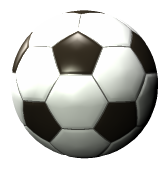Maths and football would not necessarily be two things you would put together but through the Discovering Mathematics module its become apparent that mathematics is everywhere. Liping Ma (1999) suggests that connectedness is one of the four properties of the teaching and learning of Fundamental Mathematics which led me to believe that if the teaching of mathematics was made relevant and somehow connected to what children are interested in they would be more inclined to want to gain knowledge about the topic. Football was the sport that most children in my class shared an interest inso this is why i chose to look into football in particular.
Before this I did not believe there was much maths in football at all. Maths is a sport, sports fall under the Physical Education category and as far as I was concerned that was that.Apart from the obvious score taking, shape of the pitch, angles at the corners, number of flags and players but looking into this further i realised there was so much more than I first thought.
THE BALL
Picture taken from – http://www.hoist-point.com/soccerball.htm
The football in which most people are familiar with is that of the typical black and white patterned ball. it is made of lots of leather pieces- 12 black pentagons and 20 white hexagons, all of which are regular. (Yakimento, 2015) On this football the 2D shapes are tessellated together as to leave no gaps between the shapes. The pentagons an the hexagons must have the same length of sides for this to happen. As well as this for all shapes to tessellate the angles on the corners need to add up to 360 degrees.
Tessellation, 2D Shapes and Angles are all mathematical factors involved here.
As well as this maths can be used to calculate many different things involving the ball for example… Distance the ball travels (Equation 1), Time it takes for the ball to travel (Equation 2) and finally the speed at which the ball travels at (Equation 3).
Picture taken from – www.bbc.co.uk
SCORE TAKING IN THE MATCH
Score taking is another part of football where maths is involved. The points system is simple if you score a goal you get a point against the other team. For example, If Dundee and Dundee United were to play against each other and Dundee scored the points would be 1-0 Dundee. If another goal was scored by Dundee the score would be 2-0.
Counting and addition are involved here.
TIME
Each football game lasts for approximately 90 minutes or to put this into a different format can be 1 hour 30 minutes. In my opinion, this is a difficult concept for children to grasp. The idea of conversion is an idea which children may find confusing. Conversion also has to be recognised by children in fractions to understand that, for example, 2 is the same as 2/1.
Time and conversion are the elements of mathematics that are involved here.
SHAPE AND DIMENTIONS OF PITCH
Picture taken from – www.conceptdraw.com
The football pitch is rectangular in shape which has a length from 90-120m and a width from 45-90m. However, a rectangle is not the only 2D shape visible on a football pitch. There are also circles and semi circles and more rectangles. Shapes can be used in many forms of mathematics for example, shape tessellation with the pattern on the football, calculating areas and measuring distances. The Pie symbol can be introduced to show children how to calculate the areas of circles and semi circles. As well as using the A= LxB equation format which can be used to find the areas of squares and rectangles. A follow up for this could be to change the units from metres to kilometres etc. to give children a grasp of the decimal system and working with smaller numbers. This would come under Ma’s Longitudinal Coherence property. As well as this, the older children could be introduced to Pythagoras’ Theorem on finding the areas of triangles if they have got a good understanding on how to find the areas of the other shapes found on the pitch. ( Although there are no triangles necessarily in football.)
REFERENCES
Ma, L. (1999) Knowing and teaching elementary mathematics: Teachers’ understanding of fundamental mathematics in china and the United States. United States: Lawrence Erlbaum Associates.
Yakimento, Y. (2015) Mathematics of the soccer ball. Available at: http://www.hoist-point.com/soccerball.htm (Accessed: 25 November 2015).


